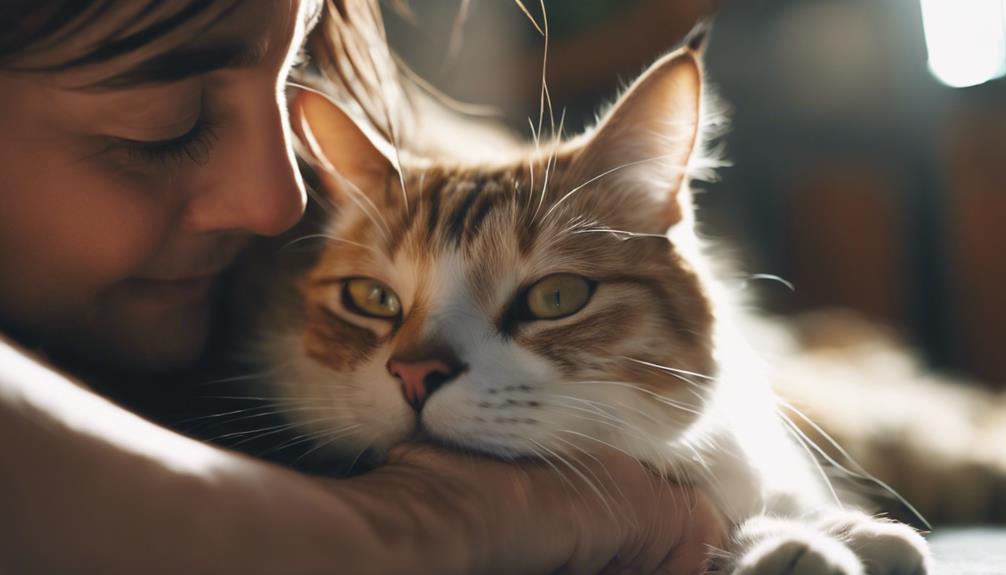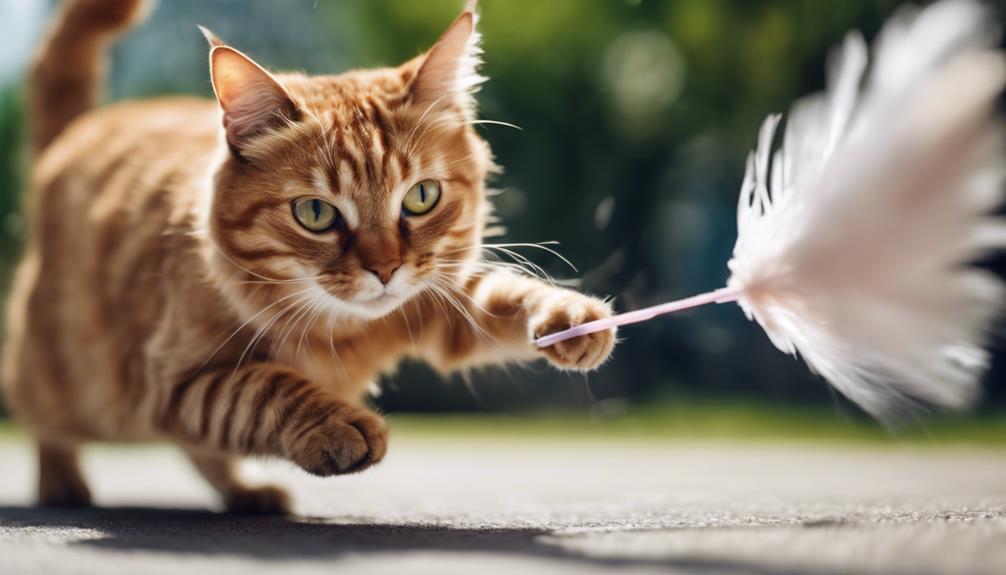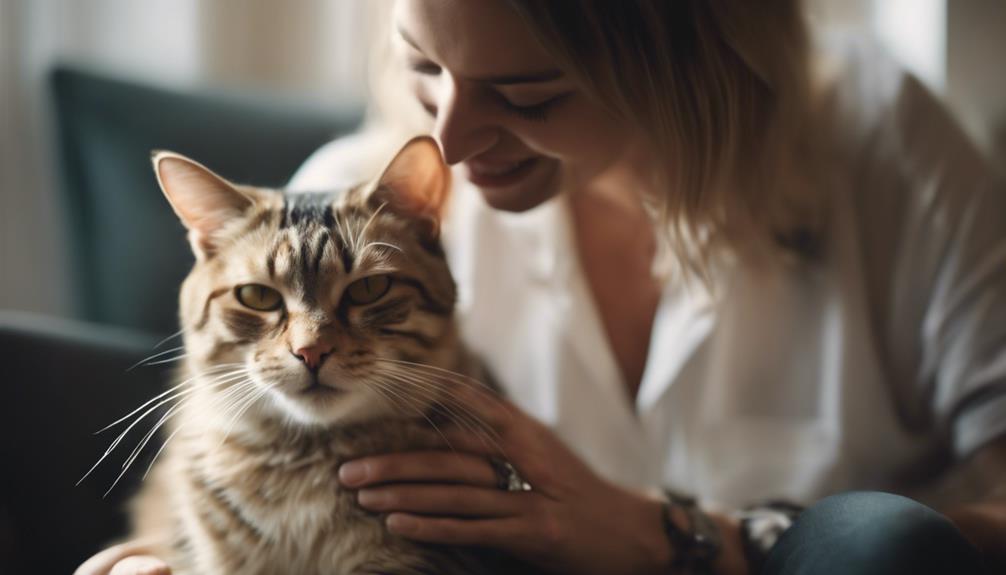In the intricate world of feline companionship, the question of whether cats truly love their owners remains a topic of interest for many. As individuals who share their lives with these enigmatic creatures, deciphering the subtle cues and behaviors that may reveal a cat's affection can be a fascinating endeavor.
By observing their interactions, understanding their unique ways of communication, and reciprocating with care and attention, pet owners can navigate the complexities of the human-cat bond. Exploring the depths of a cat's emotions and the signs that hint at their attachment to their human companions can shed light on the intricate dynamics of this special relationship.
Key Takeaways
- Cats show love through behaviors like slow blinking and seeking attention.
- Strong bonds are evident in contact behaviors like head bunting and cuddling.
- Trust and positive interactions strengthen the love between cats and their owners.
- Understanding and responding to a cat's body language fosters a loving relationship.
Signs of Cat Affection
Understanding the signs of affection displayed by cats is essential in strengthening the bond between feline companions and their owners. Cats often exhibit their love through subtle yet meaningful gestures. Preference for human interaction over treats or toys, slow blinks, and following their owners around are common signs of affection.
Contact behaviors like head bunting, rubbing against their owners, and close snuggling also indicate a strong bond. Additionally, actions such as cuddling, lap takeover, and kneading, known as 'making biscuits,' show a deep level of comfort and affection.
Recognizing and reciprocating these signs can nurture a loving relationship between cats and their owners, enhancing the overall well-being and happiness of both parties.
Understanding Cat Body Language
Cats communicate a wealth of information through their body language, providing insights into their feelings and intentions. From the position of their ears and tail to the dilation of their pupils, every movement conveys a message.
A cat with relaxed ears and gently swaying tail is typically content, while flattened ears and a flicking tail may indicate agitation. Purring often signifies comfort, but a loud, low growl suggests unease or aggression. Slow blinking is a sign of trust and affection, while direct eye contact can be perceived as a challenge.
Understanding these subtle cues can help foster a stronger bond with your feline companion and ensure a harmonious relationship based on mutual understanding.
Building Trust With Your Cat

Developing a strong foundation of trust with your feline companion is essential for nurturing a harmonious and fulfilling relationship. To build trust with your cat, consider the following:
- Consistent Routine: Cats thrive on predictability, so establish a consistent daily routine to create a sense of security.
- Respect Personal Space: Allow your cat to approach you on their terms and avoid forcing interactions.
- Positive Reinforcement: Use treats, toys, and gentle petting to reward your cat's good behavior and reinforce trust.
- Patience and Understanding: Understand that trust takes time to develop, so be patient and respectful of your cat's boundaries.
Strengthening the Human-Cat Bond
To foster a deeper connection between you and your cat, prioritize strengthening the bond through consistent positive interactions and mutual understanding. Spend quality time engaging in activities your cat enjoys, such as interactive play sessions or grooming.
Respect your cat's boundaries and preferences while offering affection and attention. Pay attention to their body language and vocalizations to better comprehend their emotions and needs. Create a safe and comfortable environment that promotes trust and security.
Establish routines that cater to your cat's well-being and provide opportunities for them to express themselves naturally. By nurturing a harmonious relationship based on trust and communication, you can enhance the bond with your feline companion.
Engaging Cats in Play

To enhance the bond with your feline companion, engaging cats in play is a pivotal aspect of nurturing a harmonious relationship based on mutual enjoyment and interaction. Cats, like humans, benefit greatly from engaging in playtime activities that stimulate both their physical and mental faculties.
Here are some ways to effectively engage your cat in play:
- Incorporate interactive toys that encourage movement and pouncing.
- Provide scratching posts and climbing structures for physical exercise.
- Rotate and introduce new toys to prevent boredom and keep them engaged.
- Experiment with different types of play, such as chasing toys, hunting games, or puzzle feeders, to cater to your cat's preferences and instincts.
Enhancing Cat-Owner Relationship
Cultivating a strong bond between a cat and its owner requires consistent effort and understanding of feline behavior cues. To enhance the cat-owner relationship, it is essential to provide a safe and secure environment where the cat feels comfortable and loved.
Learning to read your cat's body language is crucial in deciphering their emotions and needs, leading to better communication and trust-building. Engaging in positive interactions, such as gentle petting, playing, and cuddling, can strengthen the bond between you and your cat.
Additionally, respecting your cat's boundaries and preferences, while also offering enrichment activities like interactive toys and puzzle feeders, can further solidify the connection and create a fulfilling companionship for both you and your feline friend.
Addressing Cat Behavior Issues

When addressing cat behavior issues, understanding the root causes is essential for effective resolution and improving the cat-owner relationship. Cats exhibit various behaviors that may indicate underlying issues that need attention. Here are some key points to consider:
- Identifying Triggers: Recognize specific situations or stimuli that provoke undesirable behavior.
- Consistency in Training: Maintain a consistent approach to training and correction methods.
- Enrichment Activities: Provide mental and physical stimulation through interactive toys, puzzles, or play sessions.
- Consulting a Professional: Seek guidance from a veterinarian or animal behaviorist for complex behavior issues.
Conclusion
In conclusion, deciphering a cat's emotions and understanding their affection towards their owners is akin to unraveling an intricate tapestry woven with delicate threads of trust and understanding.
By observing their body language, building trust, engaging in play, and addressing behavioral issues, owners can cultivate a strong and loving bond with their feline companions.
This exploration not only enriches the human-cat relationship but also deepens our appreciation for the complexities of these enigmatic creatures.




